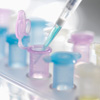Lyophilization (Freeze-drying)
A method for preserving substances without destroying their characteristics by freezing and then drying or removing the water content (ice) by sublimation.
- Why does freeze-dried food have a long shelf-life with no loss of quality?
- Possibility expanding in other fields including pharmaceuticals and the restoration of old books

Why does freeze-dried food have a long shelf-life with no loss of quality?
Freeze-dried food is a type of familiar instant food. Typical freeze-dried food includes soup, which can be enjoyed by just pouring in hot water, and tin-packed instant coffee, etc. Freeze-dried food is made through a process called lyophilization,in which the food is frozen and its water content is sublimated directly into gas at low temperature (sublimation※ ), allowing long-term preservation of the food with out a loss of flavor or quality. This process is also known as freeze-drying.
During a lyophilization process, food is generally treated under a vacuum, which dramatically speeds up sublimation. It can lower the food's sublimation point, so the water content can be sublimated into vapor quickly even at a low temperature. Thanks to the technology enabling low-temperature processing, the flavor and quality of the processed ingredients remain intact.
When dried through lyophilization, the substance will have an infinite number of microscopic pores, which rapidly absorb water and allow the product to quickly rehydrate and regain its original form.
Freeze-dried products have little residual water content, so the form of their building blocks is hardly altered. This is why they have a long shelf-life at room temperature. They are also convenient for transportation since they are light-weight. Processing food under a vacuum is advantageous also because it is easy to create an aseptic environment for production.
Possibility expanding in other fields including pharmaceuticals and the restoration of old books
As mentioned above, the lyophilization method has numerous merits, thus is adopted by various industries besides the food industry. In fact, the technology is contributing a great deal to the development of the pharmaceutical industry.
Lyophilization technology demonstrates its capability when it comes to the preservation of pharmaceutical products made up of micromolecular protein whose complex structure makes it difficult to remain stable unless it receives special treatments. Vaccines, antibody drugs, and interferon used for treating liver cancer and hepatitis C are examples of such products.
The technology, for instance, contributes to the stabilization of vaccines for diseases, such as measles, mumps, German measles, Japanese encephalitis, and chicken pox. Since lyophilized vaccines are solid, doctors, nurses, and other medical staff reconstitute them by adding the diluent provided by the manufacturer for that vaccine immediately before administering them.
Lyophilization is increasingly used in different fields. Its involvement in the expanding biopharmaceutical market is very likely, and the use of this technique is expected in manufacturing oral tablets that disintegrate more easily for infants, and for the elderly with dysphagia or problems with swallowing.
The possibility of lyophilization is expanding even into other fields. One such fi eld is the restoration of old documents for the purpose of preserving cultural assets, such as historically important documents damaged by water and mud due to natural disaster. With the lyophilization process, even documents with pages stuck together by water damage can be restored, and at the same time the freeze-drying process removes mold and mildew, which can improve the preservation level of such documents.
Lyophilization technology has also begun to be used for the preservation of living cells and microorganisms in the scientific research field and for the manufacture of photoreceptors such as organic pigments, micromolecules, and plastic materials that are required in the electrophotographic process. The technology is also used, for example, to recycle remaining liquid concrete for later use and to manufacture the new ceramic that is necessary to make dust filters. The possibility of lyophilization seems never to stop expanding.
※ Sublimation is the direct transition of a substance from the solid to the gas phase or in the reverse order without going through the liquid phase. It is a phenomenon that can be observed with dry ice transforming into vapor without being liquefied.


